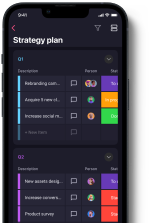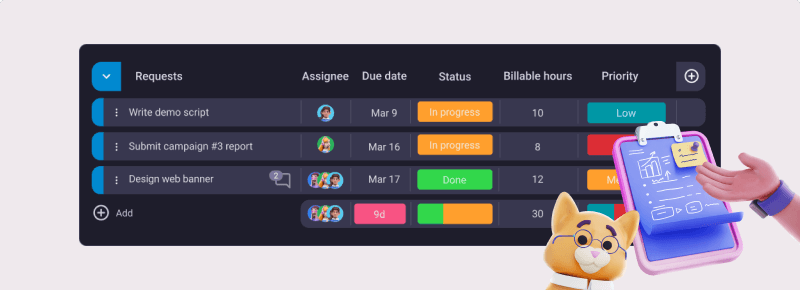Leading projects without collecting performance data is the project management equivalent of walking on a tightrope blindfolded.
The most important performance metrics — the ones selected to measure the success or progress of a project — are called key performance indicators (KPIs).
Using KPIs, project managers can measure and understand the performance of their team and/or the success of their product.
This text will dive into the topic of key performance indicators to give you 30 examples of KPIs in project management and explain how, when, and why to use them.
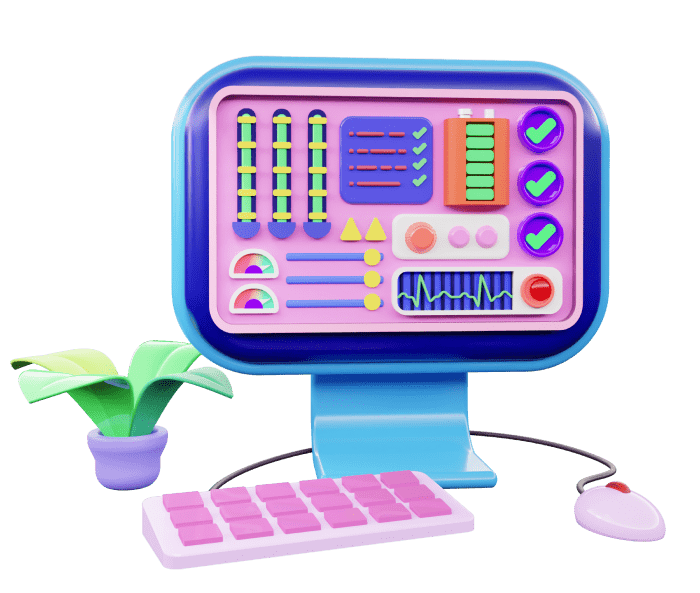
- Key performance indicators (KPIs) are used to determine how well a project is doing when compared against intended objectives.
- Examples of budget KPIs: net income, return on investment (ROI), budget variance, planned value (PV).
- Examples of time KPIs: schedule performance index (SPI), schedule variance (SV), Planned hours vs time spent.
- Examples of quality KPIs: customer satisfaction score (CSAT), net promoter score (NPS), number of change requests.
- Examples of effectiveness KPIs: percentage of canceled projects, on-time completion, milestones completed on time.
Table of Contents
What is a KPI in project management?
Key performance indicators (KPIs) are specific performance metrics used by businesses to determine how well a project is doing when compared to intended project goals and objectives.
Throughout a project, you’ll gather a lot of metrics, but they can’t all be treated as KPIs, for reasons that we’ll get into later.
KPIs can be used to measure the progress of your:
- Business,
- Portfolio,
- Program, or
- Project.
💡 PLAKY PRO TIP
Follow the link below to learn the difference between a project and a program, as well as the difference between project and program management:
Measuring the right KPIs allows project managers to see:
- What’s going well,
- What’s going badly, and
- What will go badly if things continue in the same direction.
This information enables them to make informed decisions and change strategies according to the results.
30 Examples of KPIs in project management
Listed below are 30 examples of KPIs you can use in project management divided into 4 groups according to the area of the project they relate to:
- Budget KPIs,
- Time KPIs,
- Quality KPIs, and
- Effectiveness KPIs.
Budget KPI examples
Budget KPIs help to determine how the actual project expenditures compare to the cost baseline.
These KPIs include:
- Net income,
- Return on investment (ROI),
- Budget variance,
- Planned value (PV),
- Actual cost (AC),
- Earned value (EV),
- Cost performance index (CPI), and
- Cost variance (CV).
KPI #1: Net income
Net income measures a project’s overall profitability. It’s calculated by deducting the cost of all project resources used from the project’s total revenue.
You may track this KPI at the end of the project or compare your earnings over time by tracking it periodically throughout the project (if the project is capable of generating revenue prior to its completion).
Net income = total revenue – total expenses
To maximize profitability, it’s important to know what you’re working with. Net income is such a powerful metric that it will inform your business decisions in one way or another regardless of whether you track it.
KPI #2: Return on investment (ROI)
As a KPI, ROI is used to calculate how much a project investment is worth. This business metric will show you whether the money you spend on a project will bring benefits over a certain period of time.
It’s measured by using the formula:
ROI (%) = Net income / investment x 100
KPI #3: Budget variance
Budget variance is a KPI that shows the efficiency of budget management by measuring the actual funds spent compared to the estimated expenditure.
Signs of misalignment of these 2 measures allow project managers to make early changes to the plan before the entire project goes off the rails.
💡 PLAKY PRO TIP
Budget management can be tricky. To prevent large discrepancies between your planned and actual spending, try a few of the top budgeting methods out there:
KPI #4: Earned value (EV)
Earned value (EV) represents the work that has been completed in terms of actual monetary value by comparing it to the planned budget.
In mathematical terms, this KPI is expressed as:
Earned value = % of work completed x planned budget
You can track this metric on a project basis or a task/group of tasks basis if they have a defined budget.
To give a simple example, let’s take a single task and say its estimated budget is $500. If you’re three-quarters of the way done with this task, your current earned value for that task would be $375.
EV = 75% x $500 = $375
While EV can be used as a KPI on its own, it’s more often used as a variable for calculating other KPIs under the umbrella of earned value management, such as cost variance (CV), cost performance index (CPI), schedule variance (SV), and schedule performance index (SPI), all of which we’ll talk about later in this text.
KPI #5: Planned value (PV)
PV is used to show the budget for scheduled work. This is done by multiplying the percentage of remaining work by the total project budget:
Planned value = % of remaining work x total budget
To give a simple example using round numbers, let’s say you need to build 100 computer keyboards at $50 a keyboard and can produce 10 keyboards a day. This project will last 10 days, with an estimated budget at completion (BAC) of $5,000. This is the value of the work you want to do.
The planned value of this project is expected to rise in increments of $500 a day. So, at the end of day 5, the planned value of this project is expected to be $2,500.
You can use planned value to check the project progress in terms of value generated by comparing it against earned value and actual cost.
Planned value, much like earned value, is another metric that’s typically used as a variable in other KPIs, but that can otherwise stand on its own.
KPI #6: Actual cost (AC)
Actual cost (AC), also known as actual cost of work performed (ACWP), is a KPI that shows you how much money you’ve spent on a project.
Unlike with most other KPIs, there’s no simple formula that we can show here. AC is the sum total of all project costs up to the moment of calculation. If you’re halfway through the project and you’ve spent half a million dollars, then the actual cost of your project at that moment is $500,000.
While useful on its own, actual cost is essential as input data for calculating many other KPIs featured in this guide.
For example, we can compare actual cost to planned cost to see whether the project is behind on budget.
💡 PLAKY PRO TIP
Another useful metric you can calculate once you know your AC is estimate at completion (EAC) — a projection of the total project cost at completion made while the project is ongoing. Read more about it here:
KPI #7: Cost performance index (CPI)
The cost performance index (CPI) is a KPI that shows you how above or below budget you are in percentages.
To calculate CPI, we need to divide the earned value (EV) of a project by its actual cost (AC):
CPI = EV / AC
Using the example from earlier, if the cost of building 50 keyboards was supposed to be $2,500, but you’ve spent $2,800 by the time you built the 50th keyboard, then your CPI would be 0.89.
CPI = 2,500 / 2,800 = 0.89
In other words, for every $1 spent, you’ve only gained $0.89 in value.
Because it produces results in percentages, CPI can be used to gauge the cost efficiency of the project.
💡 PLAKY PRO TIP
If you would like to learn more about the cost performance index (CPI), with examples and step-by-step instructions on how to track this KPI in Plaky, read this guide:
KPI #8: Cost variance (CV)
Cost variance (CV) is similar to CPI, only instead of displaying data in percentages, it tells you exactly how far behind (or ahead) you are compared to the planned budget in terms of actual dollars (or any other currency).
This data is derived from the following formula:
CV = EV – AC
Using the same keyboard-making example, we can see that the Cost Variance after building 50 keyboards is -$300.
CV = $2,500 – $2,800 = -$300
A negative CV shows that you’re over budget, and vice versa.
💡 PLAKY PRO TIP
If you want to learn more about cost variance, with several examples, outlined common causes of negative CV, and expert tips on keeping financial performance in check, read this guide:
Time KPI examples
Time KPIs measure all relevant information regarding the project schedule — what activities are ahead, behind, or on schedule.
They allow project managers to take preventative measures against the project going off track and make more accurate estimates about the project’s completion time.
Examples of widely used time KPIs include:
- Schedule performance index (SPI),
- Schedule variance (SV),
- Planned hours vs time spent,
- Cycle time,
- Lead time, and
- Resource utilization.
KPI #9: Schedule performance index (SPI)
The schedule performance index is a KPI that shows if and how much the project is veering off schedule in percentages.
SPI = EV / PV
For instance, the planned value of our keyboard-making example by the end of day 5 is $2,500. In other words, the schedule was made under the assumption that 10 keyboards could be produced every day at a cost of $50 per keyboard. So, 50 keyboards at $50 a pop equals our planned value of $2,500.
Now, if by the end of day 5, you’ve only managed to make 43 keyboards, your earned value would be $2,150.
Your schedule performance index, in this case, would be 0.86.
SPI = 2,150 / 2,500 = 0.86
💡 PLAKY PRO TIP
You can learn more about SPI, with examples and tips on monitoring it with software, by reading this guide:
KPI #10: Schedule variance (SV)
Schedule variance (SV) is a KPI that shows whether the project has gone off schedule or not.
It’s calculated by subtracting the project’s planned value (PV) from its earned value (EV).
SV = EV – PV
From there on, interpreting the math is simple — you’re:
- On schedule if you get an SV of 0,
- Behind schedule if SV goes below 0, and
- Ahead of schedule if you score an SV higher than 0.
Getting back to our keyboards example — the planned value by the end of day 5 is $2,500, and if you’ve made 43 keyboards instead of 50 by the end of day 5, your earned value is $2,150. This brings us to the following result:
SV = $2,150 – $2,500 = – 350
The math is clear here — having your SV below 0, you’ve fallen behind schedule.
What separates schedule variance from many other time KPIs is that it measures how far the project has progressed compared to estimated progress rather than time.
💡 PLAKY PRO TIP
For more detailed information on schedule variance, including examples and tips on making the required calculations, read this guide:
KPI #11: Planned hours vs time spent
This KPI measures the time spent to reach the desired level of progress compared to the time the project manager estimated it would take. The only difference between this KPI and schedule variance is that it uses time as its variables, rather than value.
It’s not uncommon for planned hours and time spent to be completely misaligned due to the planning fallacy — which states that people tend to underestimate the time needed to complete a task even if the estimate contradicts their previous experience.
Merely subtract the actual time spent from the planned time to get the result.
Once again, how close you are to 0 will show you how far you’ve deviated from the schedule. Negative results would indicate that you’re lagging behind and positive results that you’re ahead of schedule.
By keeping track of the planned vs actual time spent on each task, project managers can recognize early signs of having fallen for the planning fallacy trap and adjust their schedules accordingly.
KPI #12: Cycle time
Cycle time is a metric that shows how long it takes to complete a task from the moment work on it begins.
As a KPI, cycle time is often used in Kanban to identify bottlenecks in your project management workflows. It’s particularly well suited to Kanban, since it discourages multitasking, which can otherwise render cycle times inaccurate.
In addition to removing bottlenecks, calculating average cycle times can help project managers estimate the project timeline and create schedules more accurately.
KPI #13: Lead time
Lead time is a KPI that shows how long it takes to complete a task from the moment it’s been created (not from the moment you start working on it).
Lead time shows your team’s efficiency — the lower the lead time, the more efficient the team.
It also shows how quickly the team is able to implement new features or otherwise process orders.
Long lead times again point towards bottlenecks but with task prioritization as an added variable.
KPI #14: Resource utilization
Resource utilization is a KPI used by project managers to evaluate whether their resources are used effectively or they might be over or underutilized.
To check the utilization rate of your resources, use the following formula:
Resource utilization rate = total billable hours/ total hours available for work x 100
The resource most commonly used with this KPI is team member availability. If Jane, the graphic designer — who works a standard 8-hour workday — is scheduled to spend 3 hours a day on meetings or administrative work, her billable hours are 25.
If we use the above formula, we get the following equation:
25/40 x 100 = 62.5%
The utilization rate of 62.5% shows that Jane uses this percent of her work time to work on a project.
Knowing that, the project manager will decide whether to free Jane from attending all those meetings or cut her time spent on administrative work and delegate it to someone else so Jane can spend more time working on a project.
💡 PLAKY PRO TIP
Unexpected issues crop up all the time in project management and, as a result, deadlines often get missed. But there are ways to remedy this. Take a look at how you can get your project back on track if you get behind schedule:
Quality KPI examples
Quality KPIs measure the perception of the quality of work being performed. Since quality is not always an objective indicator, these KPIs are sometimes measured through surveys.
The most commonly used quality KPIs include:
- Customer satisfaction score (CSAT),
- Net promoter score (NPS),
- Number of change requests,
- Number of returns,
- Number of errors found, and
- Employee churn rate.
KPI #15: Customer satisfaction score (CSAT)
Customer satisfaction score (CSAT) falls in the category of qualitative KPIs as it is usually determined with the help of surveys.
All you need to do is ask your customers how satisfied they are with your product, service, or support. Customers rate their satisfaction on a scale of 1 to 5.
Your CSAT is the arithmetic mean of the sum of all responses:
CSAT = sum of all response scores / number of responses
The score shows how happy the customers are with the development of the project so far and how likely they are to stay loyal to the organization performing the project.
You should pay special attention to low-score responses, as they may hold the key to improving your overall customer satisfaction.
KPI #16: Net promoter score (NPS)
Much like customer satisfaction, net promoter score (NPS) is a qualitative KPI that measures user satisfaction through surveys.
Survey respondents are asked how likely they are to recommend your product/service/brand to others on a scale of 0 to 10.
The respondents are then divided into 3 groups based on the score they gave:
- Promoters (9–10) — these are loyal users who are not only happy with your product/service/brand but also likely serve as promoters, spreading the good gospel to their friends and family.
- Passives (7–8) — these are satisfied customers who are overall happy with — but not enamored by — your product/service/brand. While they don’t run the risk of damaging your reputation, they’re also far less likely to improve it. If they bought your keyboard, they’re happy with it overall but may still opt for a different brand next time.
- Detractors (0–6) — these are unsatisfied customers. At best, they’ll simply never buy something from you again. At worst, they’ll work to discourage others from trying your product/service/brand.
To calculate your Net Promoter Score, you calculate the percentage of promoters, passives, and detractors you have. Then you subtract the percentage of detractors from the percentage of promoters:
NPS = promoter % – detractor %
If 60% of survey respondents are promoters and 27% are detractors, your NPS would be 33%.
NPS = 60 – 27 = 33
NPS scores can range from -100 to 100.
KPI #17: Number of change requests
This KPI measures how many times the client has requested that changes be made to the already agreed-upon project scope.
The more changes are made, the greater the chance of project failure or low project quality.
KPI #18: Number of returns
If your project includes the creation and selling of a physical product, the number of returned items is a good indicator of product quality and customer satisfaction.
It’s similar if you’re working with a third-party contractor. The number of returns may indicate your ability to properly plan the project and choose a good contractor by measuring the times you return the delivered product due to low quality.
KPI #19: Number of errors found
Number of errors is another case of several KPIs bundled into one, the reason being that you can separately track the number of errors found:
- By QA,
- In code review, and
- By customers.
Each stage progressively shows how far errors can creep by. Moreover, each error necessitates additional work on completed tasks, thereby affecting the project timeline and budget.
KPI #20: Employee churn rate
Employee churn rate, also known as employee turnover, is a metric used to show how many employees have left the company for whatever reason.
This data is tracked by periods (quarterly, weekly) and displayed in percentages with regard to the average number of employees at the beginning of the period in question.
Churn rate = (employees who left / average number of employees) x 100
To calculate the average number of employees for any period, simply add up the number of employees you had at the beginning and end of that period and divide it by 2.
To give an example, if a project had 40 team members at the beginning of a quarter, 60 at the end, and had 7 people leave during that quarter, the math would look like this:
Average number of employees = (40 + 60) / 2 = 50
Churn rate = (7 / 50) x 100 = 0.14 x 100 = 14%
High turnover is generally associated with bad management and poor work environments.
Within the context of project management, this KPI can be used to track turnover during lengthy projects where team composition changes can be tricky, either due to confidentiality or talent shortage.
More often, though, it’s used to track the quality of hiring on the part of HR departments.
Effectiveness KPI examples
Effectiveness KPIs, also known as process KPIs, are used to measure productivity and the effectiveness with which you spend your resources.
Examples of common effectiveness KPIs include:
- Percentage of canceled projects,
- On-time completion,
- Milestones completed on time,
- Billable utilization,
- Project velocity,
- Six Sigma level,
- Process downtime,
- Conversion rate,
- Bounce rate, and
- Click-through rate.
KPI #21: Percentage of canceled projects
According to project management statistics, attempting to run too many projects at once is the number 1 cause of project failure.
With this in mind, organizations can use the percentage of canceled projects as a KPI to gauge the number of concurrent projects they can handle. Also, this KPI is an excellent indicator of whether you need to plan better, reallocate resources, or accept fewer projects in the future.
To this end, the number of canceled projects is a good metric to keep track of, especially as a percentage of all started projects.
KPI #22: On-time completion
This KPI tracks the percentage of tasks that have been completed on time or — if you’re a glass-half-empty kind of person — the percentage of tasks that have crossed the deadline.
Like the milestones missed KPI, this metric is used to track the effectiveness of your project schedule.
KPI #23: Milestones completed on time
If your project team works on projects for external clients, keeping track of project milestones completed on time as a KPI can be used as a negotiation tool to promote your team.
In this case, you would keep track of how many milestones with client sign-off you’ve hit on time versus how many you’ve missed.
KPI #24: Billable utilization
Billable utilization is a KPI that shows how much time is spent on billable activities in percentages.
The formula for calculating billable utilization is:
Billable utilization = (Number of billable hours / Number of non-billable hours) x 100
For reference, billable hours include time spent working on project tasks, whereas non-billable hours include time spent on administration, training, unrelated team meetings, or any other activity that cannot be charged to the client.
Increasing billable utilization means increasing profitability, so project managers or companies that are struggling to stay profitable could use this KPI to diagnose their current situation.
KPI #25: Project velocity
Project velocity equates to the amount of work done in a Sprint. This data is then tracked across multiple Sprints to estimate the workload teams can handle.
It’s important to note that project velocity is not meant to be a KPI for measuring performance. Rather, if we think of the project as a running track, velocity helps us predict how much distance we can cover with each Sprint, thereby acting as a scheduling tool to estimate project completion time.
Project velocity is a great KPI for Scrum teams or other project teams that work in set time intervals.
KPI #26: Six Sigma level
Six Sigma is a statistical methodology used to improve processes by reducing the number of defects.
These defects are calculated in percentage per million opportunities. In other words, if you repeat a process a million times, how likely are you to get a defective outcome? An opportunity is defined as any variable that could go wrong.
The Six Sigma scale has 6 levels, with the highest level resulting in no more than 3.4 defects per million opportunities (DPMO), or 0.00034%. Consequently, this means that processes at the highest level have a Yield (percentage of successes per million opportunities) of 0.99966%.
To calculate your Six Sigma level, you need to calculate your DPMO, which can then be used to derive the Percent Defects and Yield, which are then ranked according to the Six Sigma scale.
💡 PLAKY PRO TIP
If all of this sounds confusing, that’s because it is. If you’d like to understand how Six Sigma works in more detail, with examples of the math involved, we recommend reading our in-depth guide:
KPI #27: Process downtime
Process or operation downtime is one of the most important KPIs to track if you’re developing infrastructure that your customers will use to run their businesses.
Technically, these are 3 KPIs — service availability, number of interruptions, and duration of interruptions — all wrapped up into one, but it makes sense to track them together.
To keep things simple, let’s just say that you’re developing and maintaining a giant cloud server.
If the server goes down, your clients’ websites go down. In this case, you would track the number and duration of service interruptions as your KPI.
KPI #28: Conversion rate
The conversion rate is a KPI used to measure the percentage of users who have completed a desired action.
For example, the conversion rate is often used by SaaS companies to measure how many users who’ve visited a landing page also make an account.
Of course, this isn’t the only “desired action” you can track. Many SaaS companies also track how many trial users have been “converted” to paid users.
To calculate the conversion rate, take the number of conversions and divide it by the total number of interactions in a given period.
Conversion rate = number of conversions / number of interactions
You can think of it as a percentage of desired outcomes against all outcomes.
For example, let’s say that during the 1st quarter, 700 out of the 4,000 free trial users became paid users. In this case, your conversion rate for that quarter would be 17.5%.
Conversion rate = (700 / 4,000) x 100 = 17.5
KPI #29: Bounce rate
Bounce rate is a KPI that shows how many users leave your website after only viewing one page. Ideally, you’d want users to either navigate to other pages on your site or click on a call to action (CTA).
Bounce rate = total number of one-page visitors / total number of visits.
Note that a person going from one page of your website to another does not count as another visit.
To illustrate why this is the case, let’s say you’re visiting an art gallery.
You walk in and look at a painting, thereby becoming a visitor. If you decide to turn back and walk out, after only having seen the one painting, we could say that you’d “bounced”. On the other hand, if you decide to stick around and look at other paintings, you’d still be the same visitor.
This metric can be used to gauge user engagement as well as the effectiveness of your click-through rate.
KPI #30: Click-through rate (CTR)
Click-through rate is one of the best SEO KPIs to measure the performance of your organic visibility and/or ads.
It’s measured in the number of clicks your ads and pages get compared to the number of times these ads and pages get shown to people.
For example, whenever you Google something, every page shown through the search engine gets an impression. Impressions are pages you could have conceivably clicked on. But only the pages that you actually open are “clicked-through”.
CTR = clicks / impressions
If, for example, your ad has 7,000 impressions and 560 clicks, its click-through rate would be 0.08%.
CRT = 560 / 7,000 = 0.08%
In this case, you need a better ad.
For reference, a good click-through rate would be considered anything from 2% to 5%.
Other types of KPI categorizations
To present the above 30 examples of KPIs in an organized manner, we’ve divided them into 4 categories according to the area of the project to which they relate.
However, this isn’t the only paradigm by which we can categorize KPIs.
They can also be categorized according to:
- The level of information,
- The direction of information,
- The data source, and
- The data type.
While this isn’t a formal, textbook categorization, it helps in narrowing down the kind of KPIs you need for your project.
Let’s go through them one by one.
Types of KPIs according to the level of information
Depending on the level of information they provide, there are 3 categories of KPIs in project management:
- Strategic KPIs or outcome KPIs are focused on measuring the progress toward an organization’s strategic goals. They normally offer very high-level information. In other words, they give an overview of how the project is doing, without going into the nitty-gritty. Strategic KPIs are most often used in reports to executives who just want to know how the project is doing overall.
- Operational KPIs show information about the project’s day-to-day, week-to-week, or month-to-month progress. They offer more detailed (lower-level) information on different areas of the project and inform better decision-making based on previous experience.
- Functional KPIs offer detailed (low-level) information about different departments or teams working on a project. Normally, each team will have their own unique KPIs. HR might track employee churn rate, whereas customer support would track CSAT or NPS.
Types of KPIs according to the direction of information
Depending on the nature of the information they provide, there are 2 types of KPIs in project management:
- Leading KPIs offer information about the progress toward a certain goal. They help predict issues or successes that might happen as a result of actions taken. Leading indicators are not always accurate — but they help project managers make informed decisions.
- Lagging KPIs show information about things that have already happened. In other words, they help project managers understand how successful they were in their endeavors and why. This enables them to recreate positive outcomes and prevent recurring mistakes in the future.
Types of KPIs according to the data source
Depending on the direction KPIs come from, we distinguish between:
- Input KPIs — measure all types of resources invested in the project, and
- Output KPIs — measure the results that the project has yielded.
Types of KPIs according to the data type
Based on the data type they use for measuring, KPIs can be:
- Qualitative KPIs — measure opinions and perceptions, usually by means of surveys, opinions, or questionnaires, and
- Quantitative KPIs — measure data in raw numbers and percentages. Thanks to the clear and objective information they provide, quantitative KPIs are the most common and valuable type of performance indicators.
Why are KPIs important in project management?
Good and well-spaced KPIs will tell you:
- How your performance has changed over time and in which direction,
- How far you are from reaching your goals,
- How efficiently you’re utilizing your budget,
- How well your existing strategy is working, and
- Which areas of the project require your attention.
Let’s say your goal is to travel from Florida to New York, but you end up in Texas.
Arriving in Texas isn’t an indicator that you’ve gone off track — it’s the consequence of going off track. Your indicators were all the signposts you encountered on the road over hundreds of miles but failed to notice.
In project management, key performance indicators fulfill the role of these signposts. All you need to know is where to look for them.
When the results from measuring KPIs are not favorable, they serve as clues for project managers to figure out what went wrong and how to fix it.
KPIs can also show early signs of impending disasters and help prevent them.
Conversely, when the results are good, KPIs act as motivators and morale boosters, showing that the project team’s efforts are being well spent.
💡 Plaky Pro Tip
If your KPIs are favorable across the board, congratulations! Maybe it’s time to challenge your team and see what they can achieve with a little push and a bit bolder goals:
What are the characteristics of a good KPI?
KPIs provide precise and reliable data on your performance goals. To do the job, KPIs should be:
- Approved by all relevant parties,
- Relevant to the project and teams working on it,
- Aligned with both project and corporate goals and objectives,
- Measured on a regular basis,
- Rational and straightforward,
- Specific to a particular project,
- Defined by measurable metrics that can be analyzed across any division,
- Compatible with the company’s vision of success, and
- Considered a starting point for decision-making.
Effective KPIs are great signals of issues that can derail a project and therefore it’s vital to track them appropriately.
How to track KPIs in project management
There are 5 steps that will help you track your KPIs:
- Decide on the KPIs you wish to track,
- Define your KPI targets and frequency,
- Start tracking,
- Share results with your team, and
- Continue tracking your KPIs regularly.
Step #1: Decide on the KPIs you wish to track
The purpose of this step is to think carefully about what your real KPIs are.
There are countless performance metrics you might be tempted to track throughout your project — but only a handful are essential to your project’s success.
So, to avoid getting overwhelmed by unnecessary information and wasting time collecting unnecessary data every time a report is due, try to limit your KPIs only to those that really matter.
Step #2: Define your KPI targets and frequency
The catch to successfully measuring your KPIs is to make them as specific as possible — and, to do that, you should always make them S.M.A.R.T.
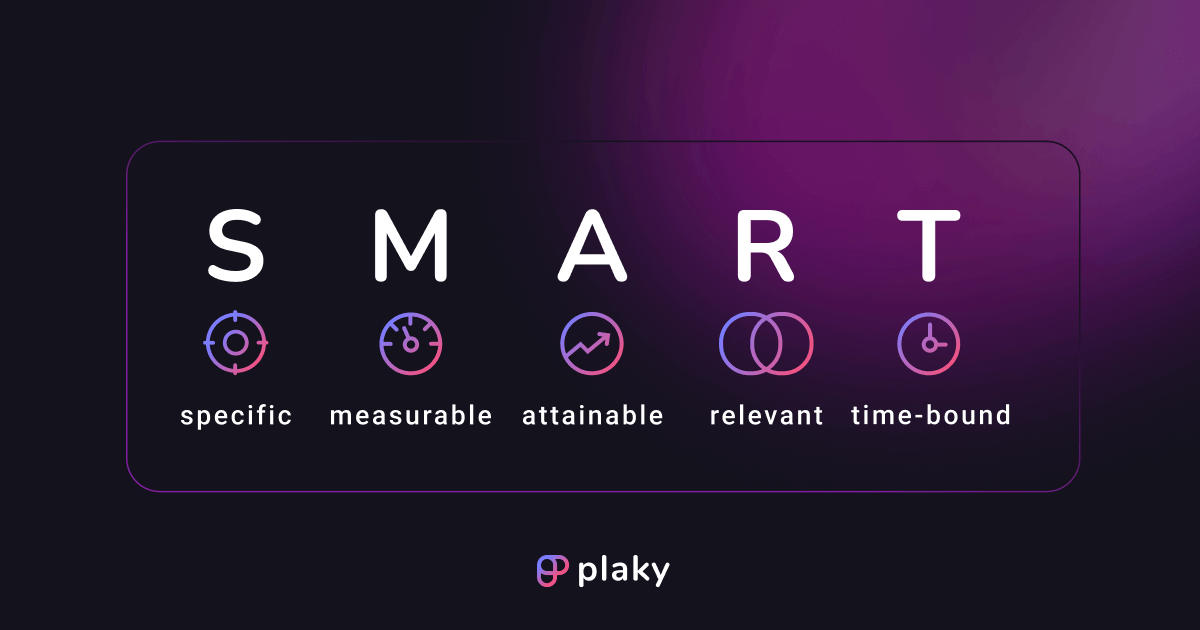
The S.M.A.R.T. acronym stands for:
- Specific — KPIs should be defined as clearly as possible to avoid any confusion when collecting and reviewing the results.
- Measurable — KPIs should be quantifiable. A KPI that can’t be objectively measured in cold hard data is unusable. Even qualitative KPIs, like CSAT, are expressed numerically.
- Attainable — KPIs should be realistic. Unattainable KPIs will reflect poorly on your team’s morale and negatively affect their performance.
- Relevant — KPIs should be relevant to your project. There are many KPIs a project manager could measure, but only a few will be relevant to your unique situation.
- Time-based — KPIs should be measured within a specific time frame. Usually, this is daily, weekly, or monthly, depending on the type of your project. This timeframe should always be the same so that project managers can accurately track performance over time.
Keep in mind that you might not always be able to set optimal goals at the beginning of a project. In these cases, don’t stress about it — use an estimate and adjust it as you go.
Once you get better acquainted with your project and gain more information, you’ll have a better idea of what’s realistic and what isn’t.
💡 PLAKY PRO TIP
For a detailed explanation of why S.M.A.R.T. goals are important and how to implement them in your project, check out our guide below:
Step #3: Start tracking
Now that you know which KPIs you’ll be using and what targets you want to hit, you can start tracking.
To keep everyone on the same page, make sure your entire team knows which KPIs you’re focusing on and why.
To make the tracking process easier, your best option is to use a project management tool to keep all your information in one place. This way, when the time comes to collect that information, everything will be gathered from the same source.
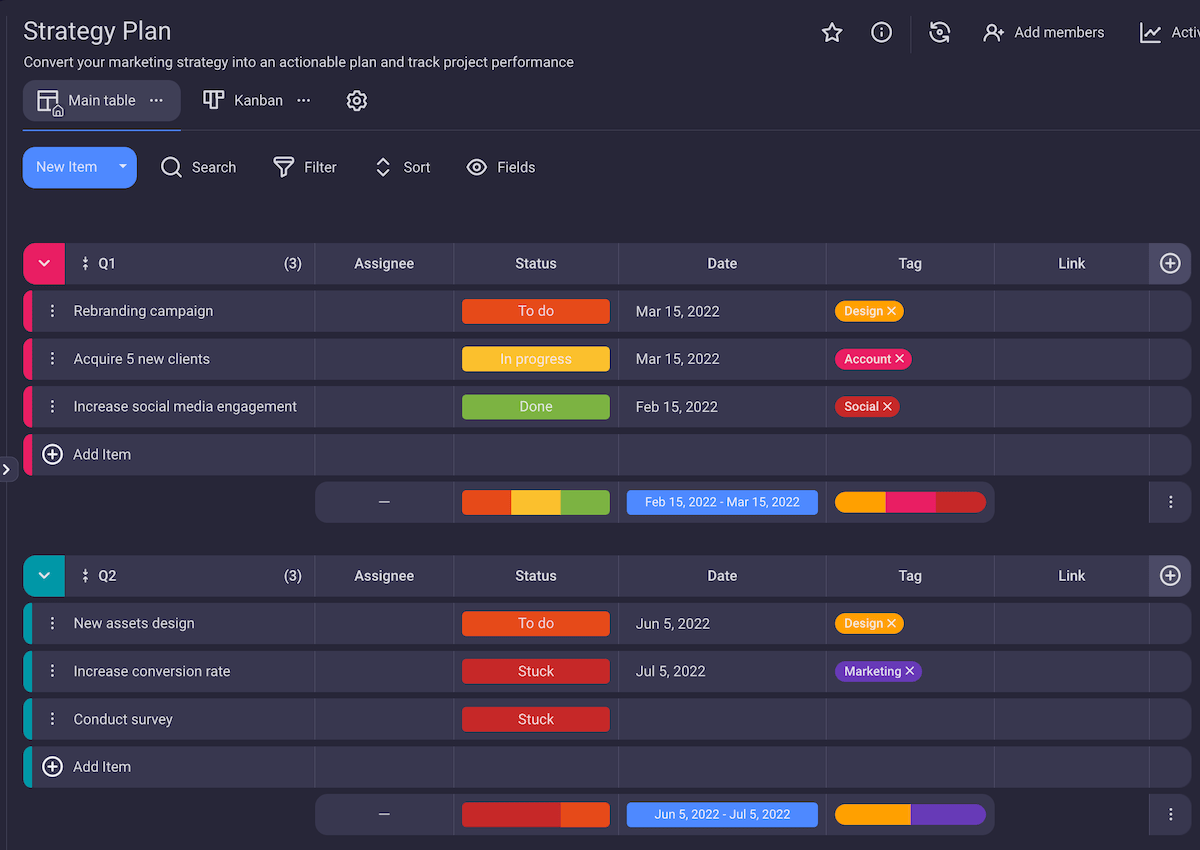
Step #4: Share results with your team
Next, it would be optimal to create a KPI dashboard where your information can be presented in the form of graphs and charts.
Depending on your style of reporting, this can be done via software or on paper and then shared with the rest of your team or your executives as part of your project status report.
Step #5: Continue tracking your KPIs regularly
Like with any statistical report, the more information you collect, the more accurate your results will be — so continue tracking your KPIs on a regular basis.
The best KPI report is one that tells a story and answers questions such as:
- How have things changed compared to last time (or over time)?
- What have we done differently since the previous report, and what is the result?
- What should we continue to do in the future, and what should we change?
This information will help you evaluate your project objectively.
Tracking KPIs is crucial for project success
Key performance indicators are the most important measures of project performance. While there are many performance indicators a project manager could (and should) track, only KPIs are used as benchmarks for evaluating project success.
By carefully choosing the KPIs you wish to track, you arm yourself with the information that will help you:
- Maintain a bird’s eye view over the project’s performance,
- Understand the variables that boost or impede your performance, and
- Notice early signs of issues and react to them on time.
Plaky offers a systematic and organized way for you to track your project’s KPIs. Sign up for a free Plaky account today and never worry about missing any vital information about your projects.



